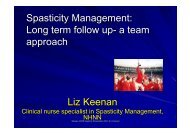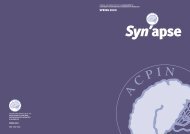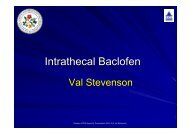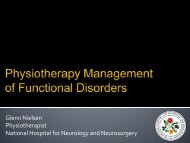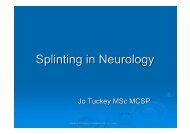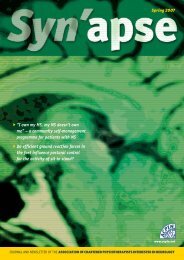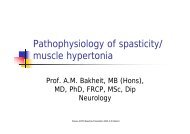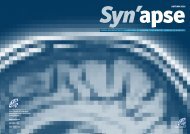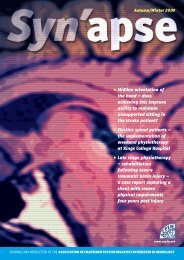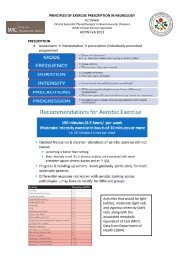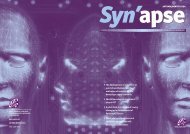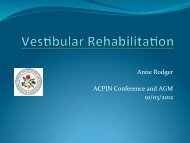SYNAPSE Spring 2009 - acpin
SYNAPSE Spring 2009 - acpin
SYNAPSE Spring 2009 - acpin
Create successful ePaper yourself
Turn your PDF publications into a flip-book with our unique Google optimized e-Paper software.
NEWS ACPIN<br />
ACPIN Presidents past and present, with the current co-chairs. From left to right; Mary Lynch-Ellerington, Margaret Mayston, Cherry Kilbride, Sue Mawson, Jo Tuckey and Sue Edwards.<br />
President’s address<br />
Margaret Mayston AM FCSP<br />
Does the hat fit?<br />
I stand next in a line of several eminent<br />
people in neurorehabilitation<br />
who have worn this hat before me<br />
and at first I was not sure that it was<br />
one which would fit me or one<br />
which I was able to wear. It was<br />
therefore with a sense of some hesitation<br />
and challenge that I contemplated<br />
whether I should accept the<br />
surprise invitation from Jo and<br />
Cherry, the co-chairpersons of ACPIN,<br />
to take on the role of President. Do I<br />
qualify for the job I asked myself?<br />
Will the hat fit? I seem to wear various<br />
hats. The clinical hat: my clinical<br />
work has mostly been in the area of<br />
paediatric neurology, although I<br />
have had a long-term interest in<br />
adult neurorehabilitation, particularly<br />
in the area of stroke. In my early<br />
days at the Bobath Centre I had the<br />
opportunity to work with people<br />
who had had a stroke with Mrs<br />
Bobath and Jennifer Bryce, who<br />
encouraged me to become an adult<br />
Bobath tutor (which I did, although<br />
it is a role I gave up long ago). So<br />
some experience there. Now to the<br />
educational hat: The MSc in<br />
Neurophysiotherapy which I coordinated<br />
at UCL until late 2007 ultimately<br />
seemed to meet the needs of adult<br />
therapists more than paediatric ones,<br />
and the evidence based course<br />
which ran successfully as part of that<br />
programme was initiated in conjunction<br />
with ACPIN after a discussion at<br />
one of these Northampton conferences.<br />
That also seemed a good<br />
qualification towards the post. The<br />
research hat? I have various interests<br />
but I have made some contribution<br />
to research into upper limb recovery<br />
after stroke, and that seemed<br />
another plus. Of course another<br />
important factor was that the people<br />
in ACPIN know how to have a good<br />
time- they are certainly not boring,<br />
and their energy and enthusiasm for<br />
neurophysiotherapy can at times be<br />
exceeded by their enthusiasm for<br />
socialising and laughter- this is very<br />
important and could be the thing<br />
that tipped the scales in favour of<br />
taking on this task! Taking all of these<br />
experiences together, plus involvement<br />
in ACPIN activities for several<br />
years, made me feel that on balance<br />
I might have something to contribute<br />
to ACPIN and its important work. I<br />
feel that we are in exciting times for<br />
neurophysiotherapy, that change is<br />
gradually taking place, that the profession<br />
is moving forward into the<br />
future in a positive and expansive<br />
way, and that ACPIN is significant<br />
contributor to that process.<br />
ACPIN is one of the largest and<br />
most dynamic special interest groups<br />
of the Chartered Society of<br />
Physiotherapy, and is run by an<br />
exceptionally enthusiastic team of<br />
volunteers, not just nationally but in<br />
its 18 regions. This meeting is another<br />
example of their dedication to<br />
improving knowledge and clinical<br />
practice for their members,<br />
ultimately to the benefit of many<br />
recipients of their services in the UK.<br />
It is therefore an honour and a privilege<br />
to take on this role as your<br />
President and I hope that I can make<br />
a positive contribution to the work of<br />
the group.<br />
Neurophysiotherapy has always<br />
been a fascinating and challenging<br />
area of physiotherapy to be part of,<br />
but as time goes on it becomes more<br />
so- knowledge increases, therapy<br />
options broaden and experimental<br />
evidence for what we do is gradually<br />
emerging. Now that therapy strategies<br />
are broadening, perhaps more<br />
thought needs to be given to specific<br />
aspects of what it is the therapist<br />
does that might make a difference to<br />
the people we work with. The idea<br />
of protocols might be alarming to<br />
some, but it will enable better definition<br />
of what we do as therapists<br />
and a basis for developing useful<br />
studies of efficacy. We have some<br />
good examples of this today in the<br />
excellent presentations by Cathy<br />
Donaldson and Amanda Wallace.<br />
So what can I contribute? I may not<br />
be working in the mainstream NHS<br />
and spend most of my time in education,<br />
but I am passionate about<br />
finding a way to achieve client-centred<br />
scientific-based practice. I fully<br />
support the multi-faceted approach<br />
to evidence based practice which<br />
encompasses knowledge, therapy<br />
expertise, and client preference, in<br />
addition to experimental evidence.<br />
We are gradually moving towards a<br />
clearer view of what we do and need<br />
to do, and several of today’s presentations<br />
are indicative of that. It will<br />
require continued lateral thinking<br />
and searching of what we do and<br />
how we do it, to reach into the<br />
future and to further develop as professionals<br />
and as a group, and it will<br />
take all of us.<br />
I love hats – so I would like to suggest<br />
that we all might practice wearing<br />
the hats of co-operative exploration,<br />
as devised by Edward de Bono- the<br />
master of lateral thinking- in 1985 (see<br />
de Bono E, 2004, How to have a<br />
Beautiful Mind? Chapter 8 Vermilion,<br />
London.) So to make this a little less<br />
boring – Presidents’ addresses have a<br />
tendency to be a bit like that – I will<br />
illustrate these different hats using<br />
some hat pictures. Where would you<br />
go to find pictures of hats? Although<br />
she is much forgotten and thought of<br />
in different ways by different people,<br />
Princess Diana had a fabulous collection<br />
of clothes and hats, which I will<br />
use as examples. The idea is that we<br />
put on our thinking cap, a coloured<br />
hat, that we all take on the same hat<br />
at the same time and fully explore the<br />
different aspects of any given situation<br />
or experience, which is related to<br />
Sarah Blanton’s challenge to us today<br />
to embrace the concept of reflective<br />
practice.<br />
1. The white hat This means information;<br />
what do we know? What do<br />
we need to know? What is missing?<br />
What question should we ask? How<br />
might we get the information we<br />
need? It is not about looking at the<br />
information that fits your own view-<br />
25



